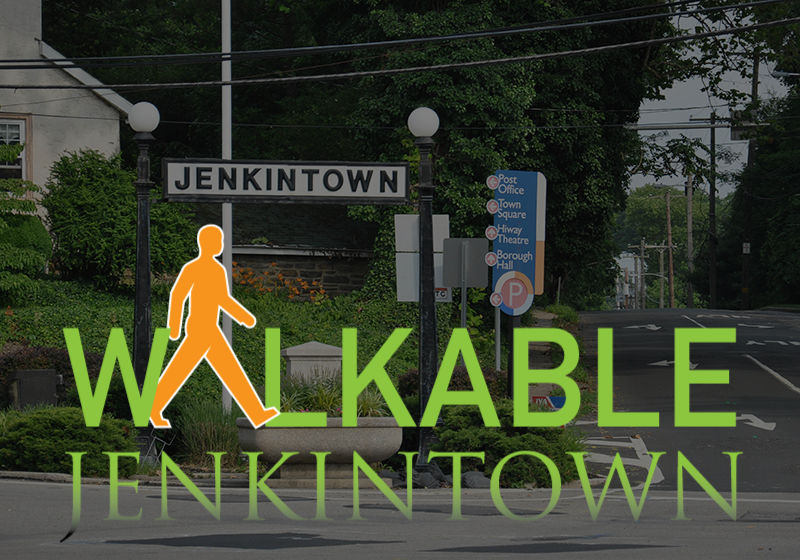This essay was originally written for the StrongTowns.org blog and was published last week. If you agree, please share this with friends and neighbors, especially if you live in Jenkintown.
Jenkintown, Pennsylvania actively promotes itself as a walkable community. Indeed, this borough that barely encompasses a square mile has sidewalks lining both sides of all of its streets. We moved here for that reason among others, but at that time, we didn’t know (and weren’t told) that Pennsylvania has what I believed a peculiar practice of making property owners directly responsible for all the physical maintenance and repair of its abutting sidewalks and curbs. I say peculiar because as a former resident of Massachusetts, we understood and never questioned that the municipality maintained all of the public right-of-way, including its sidewalks.
Last year, when Jenkintown embarked on an extensive paving program, it simultaneously conducted a mass-inspection of the sidewalks and curbs. Suddenly, the borough became of beehive of concrete contractor activity as homeowners scrambled to find someone to do the work before the deadlines.
It didn’t take long before the flaws in this system became wrenchingly evident. Contractors had a pricing advantage in that homeowners had deadlines, and their estimates reflected this. In our case, we had to replace four blocks of sidewalks and 40 feet of curb. We had initial estimates ranging from $3000 to $5000. Failure to comply with the borough meant fines of $185 per day or jail. Also, the borough makes no provision for hardship. Pay up, or go to jail, and likely have your house seized.
However, as someone coming from a state where public works departments do this work, we knew that our unit costs far exceeded that of a wholesale approach. These ordinances result in a haphazard patchwork of sidewalk styles, conditions, and qualities. Where municipalities assume responsibility for the entire public right-of-way, they replace crumbling sidewalks whole neighborhood blocks at a time, resulting in a unified, consistent look that lasts longer and costs far less.
Our own borough informed us that the PennDOT acceptable unit costs for removal and replacement of sidewalks and curbs were $90 per square yard and $35 per linear foot respectively. One contractor wanted to charge us more than $100 per linear foot for our curb job. In other words, we pay for steak but get McNuggets.
Also keep in mind that here in Pennsylvania, municipalities accept the use of concrete curbing. In Massachusetts, they typically use granite which can cost the same or less than our concrete curbs. And granite effectively lasts forever.
We have made the argument to the borough that a wholesale approach spread out over a twenty-to-thirty year period typical for a well-built sidewalk would add less than 3% to the current budget — assuming that all else stays the same. Some fear the potential tax hike that this might bring, but a budget is primarily a statement of priorities. Our borough has already borrowed $2.4 million to build a 66-space parking lot on land they seized, evicting an operating business. The debt service on this lot amounts to nearly $100,000 per year, while the borough’s entire parking fund runs an annual deficit.
To all this, I ask, what brings a walkable town greater value for its taxpayers? More beautiful, better-built streetscapes or a money-losing parking lot that effectively subsidizes the downtown business? If building a parking lot brought such great value, then why doesn’t the business community do it themselves?
Policies that place this burden upon homeowners do nothing to promote the further spread of walkable communities, especially in older suburbs like ours where the sidewalks have reached the end of their effective lifespans. We live in one of the newer sections of town, built in the late 1930s, and a walk around conspicuously shows the lack of real priority this walkable community places on its pedestrians. The borough budget covers the full freight of the asphalt between the curbs, making Jenkintown more accurately described as drivable and park-able.
In my research on this topic, I’ve found next to nothing written in support of a better, more wholesale approach. Indeed, Los Angeles has begun to backpedal on a policy established in the 1970s that took over sidewalk repair from its homeowners, many of whom lived in distressed neighborhoods. Where then might L.A. spend these tax dollars instead? I can’t say for sure, but I do know that the NFL has recently awarded the city a franchise contingent upon significant public contribution. No wonder nobody walks in L.A.
We as advocates for stronger towns and a healthier pedestrian lifestyle must address this reality and soon. In my research, I’ve found no rhyme or reason to the national distribution of sidewalk policies. Five of six New England states place the responsibility with their DPWs. Pennsylvania towns place it on property owners. Portland, Oregon requires homeowners to fix, while Portland, Maine does it themselves. Red state city Knoxville gives it to DPW while blue state Minneapolis puts the burden on homeowners.
People and businesses seeking to invest in a walkable community should expect the municipal embrace of public goods as public responsibilities. The budgets of these communities should necessarily reflect that policy and place a high priority on the quality of its pedestrian experience. We as advocates for that experience must press this point with far more force than we have in the past.




